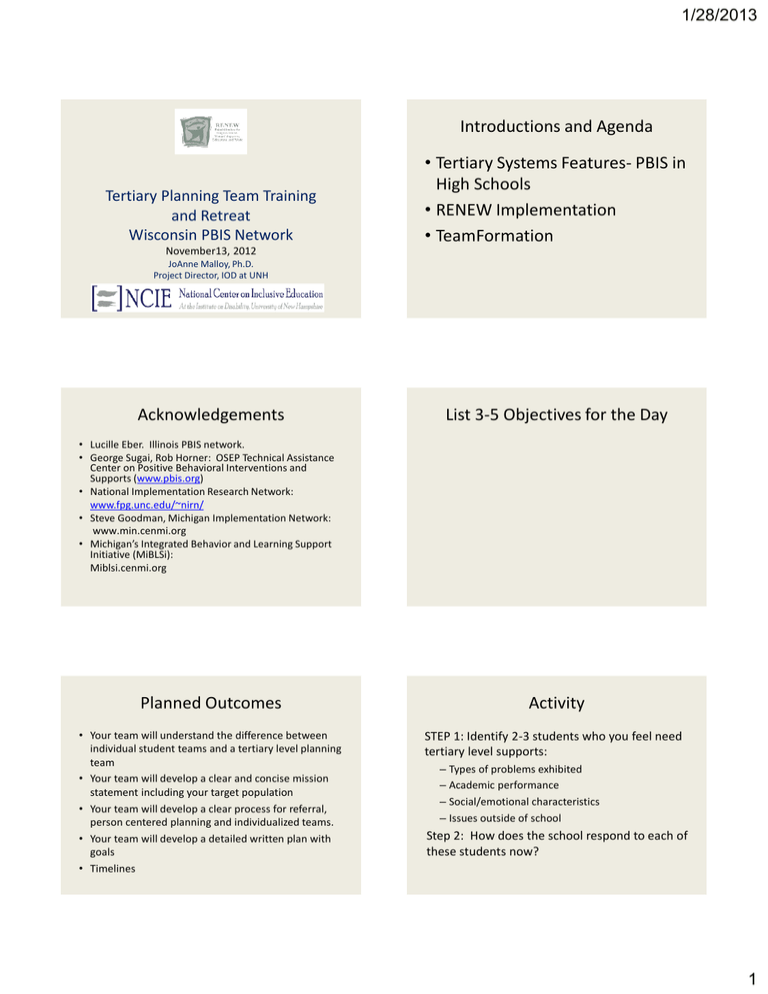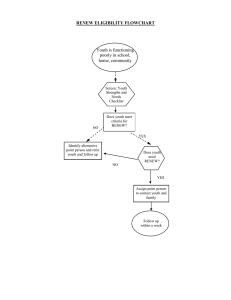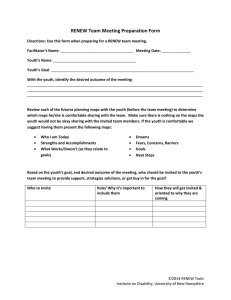Introductions and Agenda • Tertiary Systems Features- PBIS in High Schools
advertisement

1/28/2013 Introductions and Agenda Tertiary Planning Team Training and Retreat Wisconsin PBIS Network • Tertiary Systems Features- PBIS in High Schools • RENEW Implementation • TeamFormation November13, 2012 JoAnne Malloy, Ph.D. Project Director, IOD at UNH Acknowledgements List 3-5 Objectives for the Day • Lucille Eber. Illinois PBIS network. • George Sugai, Rob Horner: OSEP Technical Assistance Center on Positive Behavioral Interventions and Supports (www.pbis.org) • National Implementation Research Network: www.fpg.unc.edu/~nirn/ • Steve Goodman, Michigan Implementation Network: www.min.cenmi.org • Michigan’s Integrated Behavior and Learning Support Initiative (MiBLSi): Miblsi.cenmi.org Planned Outcomes Activity • Your team will understand the difference between individual student teams and a tertiary level planning team • Your team will develop a clear and concise mission statement including your target population • Your team will develop a clear process for referral, person centered planning and individualized teams. • Your team will develop a detailed written plan with goals • Timelines STEP 1: Identify 2-3 students who you feel need tertiary level supports: – Types of problems exhibited – Academic performance – Social/emotional characteristics – Issues outside of school Step 2: How does the school respond to each of these students now? 1 1/28/2013 Implementing a Systematic Approach: One System -- Not Fifty Activity (cont.) Step 3: What should the school’s response be? What would the ideal be? STEP 4: What is needed to reach the ideal? STEP 5: What is are the gaps between what is needed and what exists? A systematic approach to behavioral support means: 1. A Multi-tiered continuum of support 2. Data-driven decisions throughout the continuum 3. Implementing practices that encourage positive behavior & discourage repetitive concerning behavior – Implementing practices with fidelity 4. Implementing systems that decrease staff stress and support staff to implement effective practices 5. Promote Tier 1 consistency among staff and administration The APEX High School Model: Positive Behavior Interventions & Supports & RENEW Malloy, Agorastou & Drake, 2009 Adapted from Illinois PBIS Network, Revised Sept., 2008 & T. Scott, 2004 Student Progress Tracker; Individual Futures Plan Tier 3/Tertiary RENEW and Wraparound Classes chosen with behavior supports in place Simple Individual Interventions Competing Behavior Pathway, Functional Assessment Interview, Weekly Progress Report (Brief FBA/BIP, Schedule/ Curriculum Changes, etc) Tier 2 Youth identifiedemotional and behavioral support needs (Behavior and Academic Goals) ODRs, Attendance, Tardies, Grades, Credits, Progress Reports, etc. Tertiary Level Process in High Schools Universal: Small Group Interventions (CICO, Social and Academic support groups, etc) RENEW MAPPING and PLAN DEVELOPED Placement into alternative program or classes TEAM DEVELOPED (PARENT, YOUTH, KEY STAFF)PROBLEM SOLVES and Decides Other Options Extended Learning Opportunities, Work-based Learning, Job Collaboration with outside agencies- mental health vocational rehabilitation School-Wide Assessment School-Wide Prevention Systems STAGES of IMPLEMENTATION The NIRN (Fixsen, Blasé, 2005) Exploration/ Adoption Implementation Research: A Synthesis of the Literature Fixsen, D. L., Naoom, S. F., Blase, K. A., Friedman, R. M. & Wallace, F. (2005). Implementation Research: A Synthesis of the Literature. Tampa, FL: University of South Florida, Louis de la Parte Florida Mental Health Institute, The National Implementation Research Network (FMHI Publication #231). © Dean Fixsen, Karen Blase, Robert Horner, George Sugai, 2008 11 • Should we do this? Installation • Put resources and systems in place Initial Implementation • Initial pilots and assess results Full Implementation Innovation Sustainability • The practice was successful, adopt system- wide • Adopt variations of the practice and assess results • Make this the way of doing business 2 1/28/2013 Improvement Cycles ASSESSING READINESS Cycle – Do over and over again until the intended benefits are realized • Is RENEW the right think to do? And can we do it the right way? • Is there a commitment to RENEW? Has that commitment been assessed and quantified? Plan (Operationalize) • Are there benchmarks developed to assess and or determine readiness? Do Act (Trial) (Adjust) • What readiness standards are set to insure personnel are ready to implement? Study • What system benchmarks are in place to insure readiness for implementation? (Assess/Review) Shewhart (1924); Deming & Juran (1948); SixSigma (1990) RENEW SYSTEMS READINESS TOOL Features of a Systematic Problem-Solving Model RENEW Systems Feature: Implementation • Staff training and coaching schedule • System for identifying and enrolling students who need tertiary-level supports (at risk checklist based upon risk of dropping out) • Process for matching students with facilitators • Process for developing resources with a team process (special education, guidance, family members, teachers on the teams) • Process for keeping people informed and moving along (action planning and monitoring) 15 RENEW Referral Process Example: Somersworth High School • • • Training and Coaching OUTCOMES Problem Behavior Lack of Credits Failing Targeted Team: •Quick FBA Student Not Responding to Universal Interventions RENEW Point person matches with a RENEW Facilitator Student receives initial Conversation and begins RENEW % of Participants who Demonstrate Knowledge, Demonstrate New Skills in a Training Setting, and Use new Skills in the Classroom Targeted Team: Full FBA TRAINING Knowledge COMPONENTS Targeted Team: Student Triaged for RENEW Student Referred to RENEW Point person (Oversight Team) Skill Demonstration Use in the Classroom Theory and Discussion 10% 5% 0% ..+Demonstration in Training 30% 20% 0% …+ Practice & Feedback in Training 60% 60% 5% …+ Coaching in Classroom 95% 95% 95% Joyce and Showers, 2002 3 1/28/2013 Coaching RENEW Systems Features: Staff PD and Support Purposes: • Ensures fidelity • Ensures implementation • Develops clinical and practice judgment • Provides feedback to selection and training processes • Grounded in “Best Practices” • RENEW Facilitators are: Special Educators, School counselors, vocational counselors, (need school-to-career guidance and services), General education teachers. • Receive 3 days of training and additional coaching support. • Collect and use data to monitor progress, achieve youth goals and outcomes. RENEW Systems Feature: Administrative Support • Assist with resources (release time, training supports) • Empower staff to learn and practice • Schedule and supported staff with training time • Invest in problem-solving with individual student teams • Participate in individual student meetings, personal commitment and modeling • Make RENEW a priority as part of the PBIS framework and system RENEW Systems Feature: Data • Initial data-based decisionmaking and planning: Individualized – Examples: • Behavior problems (ODRS) (by teachers, subjects, use the FBA) • Attendance data: class and school • Academic: Class failures, passes, grades, (by teachers, subjects, time of day, instructional methods and supports) • Credit Gap Analysis (RENEW manual) RENEW Systems Feature: Data • Use transcripts, attendance data, progress reports, behavior reports, the student’s narrative, teacher and family input. • Use data based on student’s MAPS: Goals; barriers; needs; data. • Progress monitoring (individualized): Data is brought to every meeting • Process Monitoring (are students being served?) Implementation and Sustainability Drivers PARTICIPANT EVALUATION - CONSULTATION, COACHING, & MENTORING DATA TO SUPPORT PERFORMANCE MANAGEMENT PROGRAM EVALUATION DATA TO SUPPORT DECISION MAKING Internal ADMINISTRATIVE SUPPORTS INTEGRATED & COMPENSATORY THAT FACILITATE IMPLEMENTATION PREPARATION & TRAINING External PARTICIPANT RECRUITMENT & SELECTION SYSTEMS INTERVENTIONS Adapted from Fixsen, D.L., Naoom, S.F., Blase, K., Friedman, R.M., & Wallace, F. (2005). 4 1/28/2013 RENEW Systems Feature: Tertiary Team • Identifies pool of youth who need RENEW services • Chooses/recruits RENEW facilitators and schedules and support facilitator training • Ensure delivery of the RENEW model, with fidelity • Monitors outcomes 3-Tiered System of Support- Illinois Necessary Conversations (Teams) Universal Team Plans SW & Class-wide supports Universal Support Secondary Systems Team Problem Solving Team Tertiary Systems Team Uses Process data; determines overall intervention effectiveness Standing team; uses FBA/BIP process for one youth at a time Uses Process data; determines overall intervention effectiveness CICO Brief SAIG FBA/ BIP Group w. individual feature Complex FBA/BIP WRAP Brief FBA/BIP Sept. 1, 2009 WHERE ARE PRACTICES IMPLEMENTED? LUNCH WISCONSIN PBIS NETWORK Providing feedback and data on implementation efforts District Team DISTRICT TEAM TERTIARY PLANNING TEAM Providing supports for effective practices implemented with fidelity RENEW FACILITATORS & STUDENTS Implementation Stages Activity Our Vision for RENEW in Schools • RENEW is the planning process used to reengage students who are: – off-track for graduation (defined by your school) – chronically truant, repeatedly suspended, have significant behavior problems, at risk of out of school/district placement • What is your vision? 5 1/28/2013 Mission Statement: Brainstorm Key Words • • • • Our team will be responsible for: We will have oversight of: We are concerned about: We will do our work by: Meeting Foundation Elements • Define purpose of the team – Decisions to be made, cycle of decision making, and data source(s) to use • Define roles & responsibilities • Define team agreements about meeting processes 1. 2. 3. 4. 5. 6. Inform facilitator of absence/tardy before meeting Be prepared for meeting by completing previously assigned tasks Avoid side talk: Remind each other to stay focused Start and end on time Be an active participant Use electronic meeting minutes 1/28/2013 32 Identify Team Member Roles • Team Leader - starts the meeting, reviews the purpose of the meeting, facilitates the meeting by keeping the team focused on each step • Recorder - taking notes, transcribing the team’s responses on flip chart paper, transparency, etc • Timekeeper- monitors the amount of time available keeps the team aware of time limits by giving “warnings” (i.e., “10 minutes left”) Data Specialist- is trained in entering and accessing data from the SWIS data system • • • CONSENSUS Content Specialist- competent with behavioral principles and assists in analyzing data Administrator- actively encourages team efforts, provides planning time, feedback, and support initiatives • Communications – acts as the point person for communication between the team and staff regarding PBIS and behavior issues • PBIS Coach- district-level (external) or school-based (internal) individual that facilitates the team through the process, becomes the school’s main contact Harkin, 2009 Consensus does NOT mean: • • • • • A unanimous vote A majority vote Result is everyone’s first choice Everyone agrees Conflict or resistance will be overcome immediately Levels of Agreement Identify decision rule (e.g., 3 or above) 1. I enthusiastically agree! 2. Yes, I agree. 3. I have minor reservations, and generally agree. I will actively support the decision of the group. 4. I have major reservations and would like more dialogue before moving forward. 5. I will actively work against this idea. I do not think it is in our best interest to move forward. 6 1/28/2013 Effective Consensus Process Levels of Agreement Tool HOW to USE it: • Someone makes a statement that he/she needs consensus on. • If anyone holds up four or five fingers, the group has not reached consensus. You will need more discussion or dialogue. I believe the group has heard me; and I can actively support the group's decision as the best possible at this time, even if it is not my first choice. • If you get all “1” or “2” fingers showing, you can declare consensus (“A decision with high level agreement.”) • If you get some members showing “3” fingers, you might make a list of concerns to see if the group can address them prior to making a FINAL DECISION. 15 minute • All group members contribute everyone’s opinions are voiced, heard and encouraged • Differences are viewed as helpful • Everyone agrees not to sabotage the action or decision made by the group • Members agree to take responsibility for implementation • RESULTS in more sustainable agreements Collaborative Team Checklist B R E A K 2/11/2011 Meeting Norms • Activity: Implementation Team Meeting Notes Team Name:________________________________________________ Date:______________________ Moderator/Facilitator:________________________________________ Note Taker:_________________________________________________ AGENDA ITEMS: Item/ ISSUE (General) DECISION MADE ACTION ITEMS (WHAT) WHO WHEN – Pet Peeves: – Best Meetings Ever: • 7 1/28/2013 ACTIVITY: Goal Setting/Data Activity: Tertiary Level Checklist (TLC) • How many students in your school fall within the Tertiary level of need? • What are the data telling you (observe)? • How many students can you support this year? Next year? • What do you expect the outcomes to be for those students?: – Attendance – Courses passed – Behavior problems reduced Performance Assessment Purposes: • Measure fidelity • Ensure implementation • Reinforce staff and build on strengths • Monitor Outcomes • Feedback on functioning of – – – – DATA: “Trust… but verify…” • Process Data (PROGRESS TRACKER) • Fidelity (RENEW Integrity Tool) Recruitment and Selection Practices Training Programs (pre and in-service) Supervision and Coaching Systems Interpretation of Outcome Data Goal Setting Activity Based upon the data: By June of 2013, we will have accomplished: Suggested Timeline for now-2013 • Use the PLANNING Tool to complete a plan. • Specific measures: 8 1/28/2013 NEXT STEPS Meeting Evaluation • Plan to choose people to attend facilitator training • Next Team Meeting (date and time): • Agenda items: • Roles (facilitator, note taker, timekeeper): • Location Contacts JoAnne Malloy, Ph.D. Clinical Assistant Professor Institute on Disability at the University of New Hampshire Joanne.malloy@unh.edu www.iod.unh.edu 9

